
Lunenburg is a port town on the South Shore of Nova Scotia, Canada. Founded in 1753, the town was one of the first British attempts to settle Protestants in Nova Scotia.
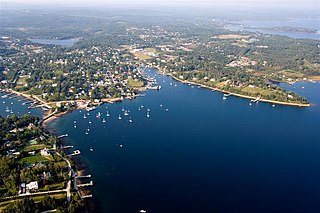
Chester is a village on the Chester Peninsula, Mahone Bay, Nova Scotia, Canada. The nearby waters of Mahone Bay and its numerous islands are well known for yachting and have made the Chester Yacht Club into a cruising destination. A provincial ferry from the village provides a schedule of daily trips to Big Tancook Island and Little Tancook Island.

Tatamagouche is a village in Colchester County, Nova Scotia, Canada.
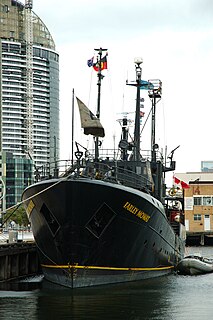
RV Farley Mowat was a long-range, ice class ship. Originally built as a Norwegian fisheries research and enforcement vessel, she was purchased by the Sea Shepherd Conservation Society in Edinburgh, Scotland, in August 1996. Originally named Sea Shepherd III, the name was changed in 1999 to Ocean Warrior, before eventually being renamed in 2002 after Canadian writer Farley Mowat.
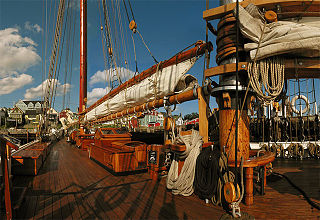
Bluenose II is a replica of the fishing and racing schooner Bluenose, commissioned by Sidney Culverwell Oland and built in 1963 as a promotional yacht for Oland Brewery. Sidney Oland donated the schooner to Nova Scotia in 1971 and it has since operated as a sailing ambassador and promotional device for Nova Scotia tourism. In honour of her predecessor's record, Bluenose II does not officially race.

Hosting the region's largest urban population, Halifax, Nova Scotia is an important cultural centre in Atlantic Canada. Halifax is home to a vibrant arts and culture community that enjoys considerable support and participation from the general population. As the largest community and the administrative centre of the Atlantic region since its founding in 1749, Halifax has long-standing tradition of being a cultural generator. While provincial arts and culture policies have tended to distribute investment and support of the arts throughout the province, sometimes to the detriment of more populous Halifax, cultural production in the region is increasingly being recognized for its economic benefits, as well as its purely cultural aspects.

Mary Helen Creighton, CM was a prominent Canadian folklorist. She collected over 4,000 traditional songs, stories, and beliefs in a career that spanned several decades, and she published many books and articles on Nova Scotia folk songs and folklore. She received numerous honorary degrees for her work and was made a Member of the Order of Canada in 1976.
Nova Scotia Museum (NSM) is the corporate name for the 27 museums across Nova Scotia, Canada, and is part of the province's tourism infrastructure. The organization manages more than 200 historic buildings, living history sites, vessels, specialized museums and about one million artifacts and specimens, either directly or through a system of co-operative agreements with societies and local boards. The NSM delivers programs, exhibits and products which provide both local residents and tourists in Nova Scotian communities an opportunity to experience and learn about Nova Scotia's social and natural history. More than 600,000 people visit the facilities each year.

Sambro Island Lighthouse is a landfall lighthouse located at the entrance to Halifax Harbour, Nova Scotia, on an island near the community of Sambro in the Halifax Regional Municipality. It is the oldest surviving lighthouse in North America and its construction is a National Historic Event.

Chebucto Head is a Canadian headland on Nova Scotia's Chebucto Peninsula located within the community of Duncan's Cove.
Carolyn Bolivar-Getson is a Canadian politician. She represented the electoral district of Lunenburg West in the Nova Scotia House of Assembly from 2003 to 2009 as a member of the Progressive Conservatives.

Bunker's Island is a peninsula located in Yarmouth Harbour in Yarmouth County, Nova Scotia. It contains a lighthouse which is nicknamed Bug Light by the locals and, until recently, it also contained Irving oil tanks and a wharf. The tanks were removed in 2017.

Haven is a fictional town on the Maine coast, which is the center of events in the supernatural TV series Haven. It is not far by boat to Camden and the police send forensic material to Bangor. Images of Haven are mainly derived from the town of Lunenburg, Nova Scotia, which is one of the main locations where the series is filmed, along with the village of Chester, Nova Scotia, which provides many of the shop fronts used in the series.
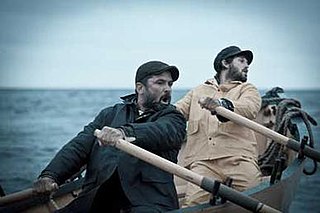
The Disappeared is a Canadian drama film written and directed by author and filmmaker Shandi Mitchell. A story of survival and self-discovery for six men lost at sea in the North Atlantic, it stars Billy Campbell, Shawn Doyle, Brian Downey, Gary Levert, Ryan Doucette, and Neil Matheson.

Low Point Lighthouse is a historic Canadian lighthouse marking the eastern entrance to Sydney Harbour at New Victoria, Nova Scotia, near New Waterford, Nova Scotia. This is one of the earliest and most important light stations of Nova Scotia, one of the first dozen beacons in Nova Scotia to be lit to guide mariners, a classic red-and-white lighthouse still operated by the Canadian Coast Guard.
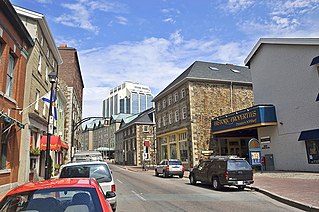
The Historic Properties are warehouses on the Halifax Boardwalk in Halifax, Nova Scotia that began to be constructed during the Napoleonic Wars by Nova Scotian businessmen such as Enos Collins, a privateer, smuggler and shipper whose vessels defied Napoleon's blockade to bring American supplies to the British commander Duke of Wellington. These properties helped make Halifax prosperous in Canada's early days by aiding trade and commerce, but they were also frequently used as vehicles for smuggling and privateering. During the War of 1812, two of the most successful Nova Scotian privateer ships during this time period were the Liverpool Packet and the Sir John Sherbrooke.
Milne Charles "Mel" Pickings was a Canadian politician. He represented the electoral district of Lunenburg West in the Nova Scotia House of Assembly from 1978 to 1988. He was a member of the Progressive Conservative Party of Nova Scotia.

Pictou Harbour is a natural harbour in Nova Scotia on the Northumberland Strait.

The Lunenburg Academy is a historic school building located in Lunenburg, Nova Scotia. Constructed in 1895 to replace a building that had been destroyed by fire, the Academy operated as a school from 1895 until 2012, when the Town of Lunenburg took over the property. It was designated a National Historic Site in 1983 for its distinctive Second Empire architectural features and its illustration of Nova Scotia's education system in the 19th century. As of 2019, the building houses a library and music school, and restoration efforts are ongoing.

The Eastern Shore is a tourism region of the province of Nova Scotia, Canada. It provides two percent of the revenue for the province's tourism economy. One of its key features is an archipelago known as the 100 Wild Islands area.
















